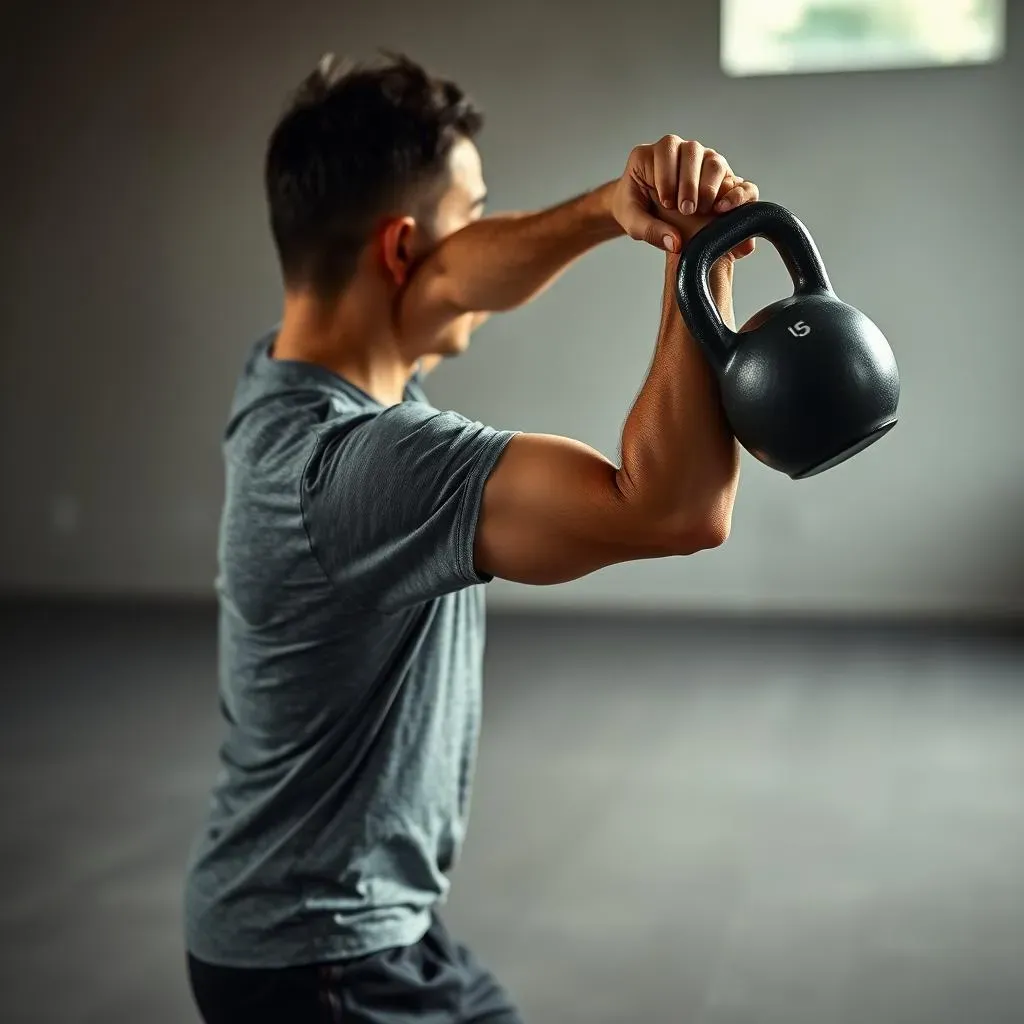Table of Contents
Ever felt like your regular workout routine needed a serious shake-up? I did too, that is why I discovered the 1 arm kettlebell swing. It's not just another exercise; it's a power move that can transform your strength, stability, and even your coordination. Forget those boring, symmetrical lifts. This single-arm variation throws a curveball at your muscles, forcing them to work harder and smarter. We're not just talking about bicep curls here; we are talking about full-body engagement. This article will guide you through the whys and hows of this exercise. First, we will look at why you would even bother with one arm, then will go over step-by-step instructions, and finally, we will look at some common mistakes and how to fix them, so you can nail the 1 arm kettlebell swing. Get ready, because it's time to swing into action and discover what your body is truly capable of.
Why Go Single? The Benefits of the 1 Arm Kettlebell Swing

Why Go Single? The Benefits of the 1 Arm Kettlebell Swing
Unlocking Asymmetrical Awesomeness
Okay, so you've probably seen people swinging kettlebells with two hands. It's a classic, and it's great. But what happens when you ditch one hand? That is where the magic of the 1 arm kettlebell swing starts. It's like turning up the difficulty level on a video game. Suddenly, your core has to work overtime to keep you from twisting like a pretzel. This isn't just about getting stronger; it's about getting *smarter* with your strength. It is about control and stability.
When you do a two-handed swing, both sides of your body are working together. But when you switch to one arm, your body needs to work extra hard. It is like trying to balance a broomstick on one finger. Your core muscles, those deep stabilizers that you usually forget about, are activated like crazy. This creates a stronger, more resilient core. It is not just about abs, it is about your whole midsection.
Benefit | Why It Matters |
|---|---|
Core Strength | Resists rotation, builds a solid midsection. |
Grip Strength | Forces your hand to work harder to hold on. |
Balance & Stability | Challenges your body to stay upright. |
Muscle Imbalance | Helps you fix strength differences between sides. |
Grip Like a Gorilla
Let's talk about your grip. When you're gripping that kettlebell with one hand, it's not just about holding on. It is about your whole hand and forearm working together. Think of it like squeezing a stress ball, but with a lot more weight involved. This translates to better grip strength for everything else you do. Whether you're carrying groceries or pulling yourself up on a bar, a strong grip is an important tool.
Plus, let's be honest, it feels pretty cool. There's something primal about swinging a heavy weight with one hand. It's like you're channeling your inner ape, but in a controlled and safe way, of course. This exercise can challenge your body in a way that not many other exercises can.
Fixing Imbalances and Boosting Coordination
Ever notice that one side of your body is stronger than the other? It's super common, and the 1 arm kettlebell swing can help you even things out. By working one side at a time, you force your weaker side to catch up, creating a more balanced physique. This exercise isn't just about strength; it's about making your whole body work together as a well-oiled machine. It's about creating a body that moves efficiently and powerfully.
Think of it like this: your body is a car, and your muscles are the engine. If one side of the engine is weaker, the car won't run smoothly. The 1 arm kettlebell swing helps tune up that engine, making sure everything works in harmony. It is a great exercise if you want to improve your coordination and become more efficient in your movement
1 Arm Kettlebell Swing: StepbyStep Guide

1 Arm Kettlebell Swing: StepbyStep Guide
Getting Ready: The Setup
Alright, let's get into the nitty-gritty of the 1 arm kettlebell swing. First things first, you need to set yourself up correctly. Imagine you're about to start a race; you wouldn't just stand there all wobbly, right? Same deal here. Start with your feet a bit wider than shoulder-width apart. Think "athletic stance," like you're ready to jump. Place the kettlebell slightly in front of you, not directly between your feet. This allows for a better range of motion and prevents you from smashing your shins. Now, hinge at your hips, pushing your butt back like you're about to sit in a chair. Keep your back straight – no rounding! This is crucial for a safe and effective swing. Your eyes should be looking straight ahead, not down at the floor.
This initial setup is the foundation of the whole exercise, and if you don't get this right, the rest of your swing won't be as effective or safe. So, take your time, get comfortable, and make sure everything feels solid before you even think about picking up the kettlebell. It's like building a house; if the foundation is shaky, the whole thing is going to fall apart.
The Swing: Power from the Hips
Okay, you’re set up, now it’s time to swing! Grab that kettlebell with one hand. Remember, grip it firmly but don't strangle it. Now, hike the kettlebell back between your legs, like you're hiking a football. This is where the power starts. Then, explode your hips forward, using that momentum to swing the kettlebell up. Think of it as a pendulum, not a lift. Your arm is just along for the ride. It is not about lifting with your arm; it is about using the power of your hips. As the kettlebell swings up, don't let it go higher than your chest. It should feel like a natural, fluid motion, not a forced, jerky one. Keep your core engaged throughout the whole movement. This helps you maintain control and prevents any unwanted back strain.
The whole swing is a dance between your hips, your core, and your grip. It’s not about brute force; it’s about using your body efficiently. It's like a perfectly timed wave, where all the parts work together to create a powerful surge. If you feel like you're using your arm too much, slow down and focus on engaging your hips more. The hips are the engine; the arm is just the guide.
Step | Action |
|---|---|
1 | Stance: Feet shoulder-width apart, bell slightly in front. |
2 | Hinge: Push hips back, keep back straight. |
3 | Grip: Grab the bell firmly with one hand. |
4 | Hike: Swing the bell back between your legs. |
5 | Swing: Explode hips forward, swing bell up. |
6 | Control: Keep core engaged, control the swing. |
The Descent: Control is Key
What goes up must come down, right? The downward part of the swing is just as important as the upward part. As the kettlebell swings back down, guide it with your arm, and control the momentum with your hips. Don't just let it drop! Hinge at your hips again, getting ready for the next rep. It should feel like a smooth, controlled movement, not a crash landing. Think of it like a controlled fall, where you’re guiding the kettlebell back to its starting position. If you lose control on the way down, you’re more likely to injure yourself. This exercise is about control, stability, and power, all working together in harmony.
The descent is not just about controlling the kettlebell; it's also about preparing for the next swing. You should feel like you’re loading up the spring of your hips, ready to explode forward again. It’s a continuous cycle of power and control, like a well-oiled machine working in perfect rhythm. This is where you get stronger and more efficient with each rep. Remember: control on the way down equals power on the way up.
Common Mistakes in the 1 Arm Kettlebell Swing

Common Mistakes in the 1 Arm Kettlebell Swing
Rounding Your Back: The Silent Killer
Okay, let’s talk about a big no-no: rounding your back. It's like a siren song for back pain, and I see it all the time. When you round your back during the swing, you're putting a ton of pressure on your spine. Instead, think of maintaining a neutral spine, like you're balancing a book on your head. Your back should be straight, not curved like a rainbow. Engage your core, push your chest out a bit, and keep your eyes looking ahead. This will help you maintain proper alignment and avoid any unnecessary strain. It’s like building a bridge; if the foundation is curved, the whole thing is going to crumble.
Rounding your back is often a sign that you're trying to lift too much weight, or that your core isn't engaged properly. It is important that you focus on good form before you start worrying about how much weight you can swing. It's better to use a lighter kettlebell and maintain good form than to go heavy and risk injury. Remember, it’s not about how much you can lift; it’s about how well you can lift it. A good swing is a safe swing.
Pulling with Your Arm: The Wrong Kind of Muscle
Another big mistake? Pulling the kettlebell up with your arm. I know, it’s tempting to use your arm, but the 1 arm kettlebell swing is not an arm exercise. It is all about using the power of your hips and core. Your arm should just be along for the ride. Think of it like a rope attached to a pendulum; the rope doesn't lift the pendulum, it just guides it. If you find yourself using your arm, slow down, and focus on pushing your hips forward. Your arms should only be there to hold the kettlebell. The power should come from your hips, not your biceps. It’s like a whip; the handle starts the motion, and the rest of the whip follows.
When you pull with your arm, you're not only wasting energy, but you're also putting unnecessary strain on your shoulder. You want to keep your shoulder relaxed, not tense. Instead of thinking about lifting the kettlebell, think about swinging it. It’s a subtle but important difference. If your arm is screaming at you, you're doing it wrong. You should feel the work in your glutes, core, and hamstrings, not in your shoulders and biceps.
Mistake | Why It's Bad | How to Fix It |
|---|---|---|
Rounding your back | Puts pressure on your spine, can cause injury. | Engage core, keep back straight, look ahead. |
Pulling with your arm | Wastes energy, puts strain on shoulders. | Focus on hip drive, relax your arms. |
Not using your core | Causes instability, reduces power. | Engage your core throughout the movement. |
Not Engaging Your Core: The Powerhouse
And last but not least, we have not engaging your core. Your core is like the engine of your body; it's where all the power comes from. If you’re not using it, you’re missing out on a huge part of what makes the 1 arm kettlebell swing so effective. A weak core can also lead to all sorts of problems, including lower back pain and poor balance. Think of your core like the central pillar of a building. If it’s not strong, the rest of the building is going to be unstable. When you engage your core, you're creating a solid foundation for your swing, allowing you to generate more power and stay in control.
To engage your core, think about pulling your belly button towards your spine. This will create tension in your midsection and keep you stable. It's not about sucking in your stomach, but about creating a solid brace. This brace should be maintained throughout the entire movement. If you feel your core is not activated, try doing some planks or other core exercises before you start your swings. It’s like warming up your car before you take it for a drive; a good warm-up ensures a smoother ride. This is the key to a safe and powerful swing.
Training Tips and Progressing Your 1 Arm Kettlebell Swing

Training Tips and Progressing Your 1 Arm Kettlebell Swing
Start Light, Stay Right
Alright, so you've got the basics down, but how do you make sure you're actually getting better? First things first, leave your ego at the door. Start with a lighter kettlebell than you think you need. Seriously. It's like learning a new dance move; you wouldn't try to do a complicated routine on your first day, right? You need to get the rhythm of the swing first. Focus on perfecting your form, and the weight will come later. It's better to do ten perfect reps with a light weight than two sloppy ones with a heavy weight. This isn't a race; it's a journey. And like any good journey, you need to start with a solid foundation. This approach is not just about being cautious; it's about building a base that will support you as you progress.
Once you've mastered the movement with a lighter weight, then you can slowly start to increase the weight. But remember, slow and steady wins the race. There is no rush. You should not increase your weight if you feel any pain or if your form is not perfect. It's like cooking a great meal; you can't rush the process. You need to take your time, let the flavors develop, and enjoy the journey. So, be patient, be consistent, and you'll get there. This is the time when you really start to see the benefits of the exercise, but only if you're doing it right.
Tip | Why It Helps |
|---|---|
Start light | Focus on form, avoid injury. |
Slowly increase weight | Build strength gradually, maintain form. |
Listen to your body | Avoid overtraining, prevent injuries. |
Practice Makes Perfect
Consistency is key. It is like learning to play a musical instrument. You wouldn't expect to become a virtuoso overnight, right? You need to practice regularly, and the same goes for the 1 arm kettlebell swing. Try to incorporate it into your workouts a few times a week. Don't overdo it, especially when you're starting out. It's like planting seeds; you need to give them time to grow. If you overdo it at the start, you'll just burn out. Space out your sessions to allow your body to recover. This will help you stay consistent and avoid injuries. Remember, it's about the long haul, not just a quick fix.
You can start with a few sets of ten reps, and gradually increase the reps as you get stronger. Focus on quality over quantity. It is better to do fewer reps with great form than a ton of reps with bad form. It is like writing a book; it is not about how many pages you write, it is about how well you write them. So, be patient, be consistent, and you'll see the results. This isn't just about the exercise itself; it's about building discipline and a healthy routine. A little bit of consistent effort goes a long way.
Listen to Your Body
Finally, and this is super important, pay attention to what your body is telling you. If something feels off, stop. Don't try to push through pain; it's a sign that something is not right. It's like your body is sending you a text message saying, "Hey, something's wrong!" It’s important to listen to that message. You can take a break, adjust your form, or reduce the weight. It's not about being weak; it's about being smart. You need to be in tune with your body and respect your limits. Pushing too hard when you're tired or in pain is a recipe for disaster. It's like driving a car with a flat tire; you're going to damage something.
Rest and recovery are just as important as the workout itself. Your muscles need time to rebuild and get stronger. So, make sure you're getting enough sleep, eating well, and giving your body the time it needs to heal. It is important to think of your body as a high-performance machine; it needs to be maintained to function optimally. If you’re not taking care of yourself, you won't see the results you're looking for. This is not just about the exercise; it's about creating a healthy, sustainable lifestyle. So, be kind to your body, listen to its signals, and you'll be able to train for years to come.